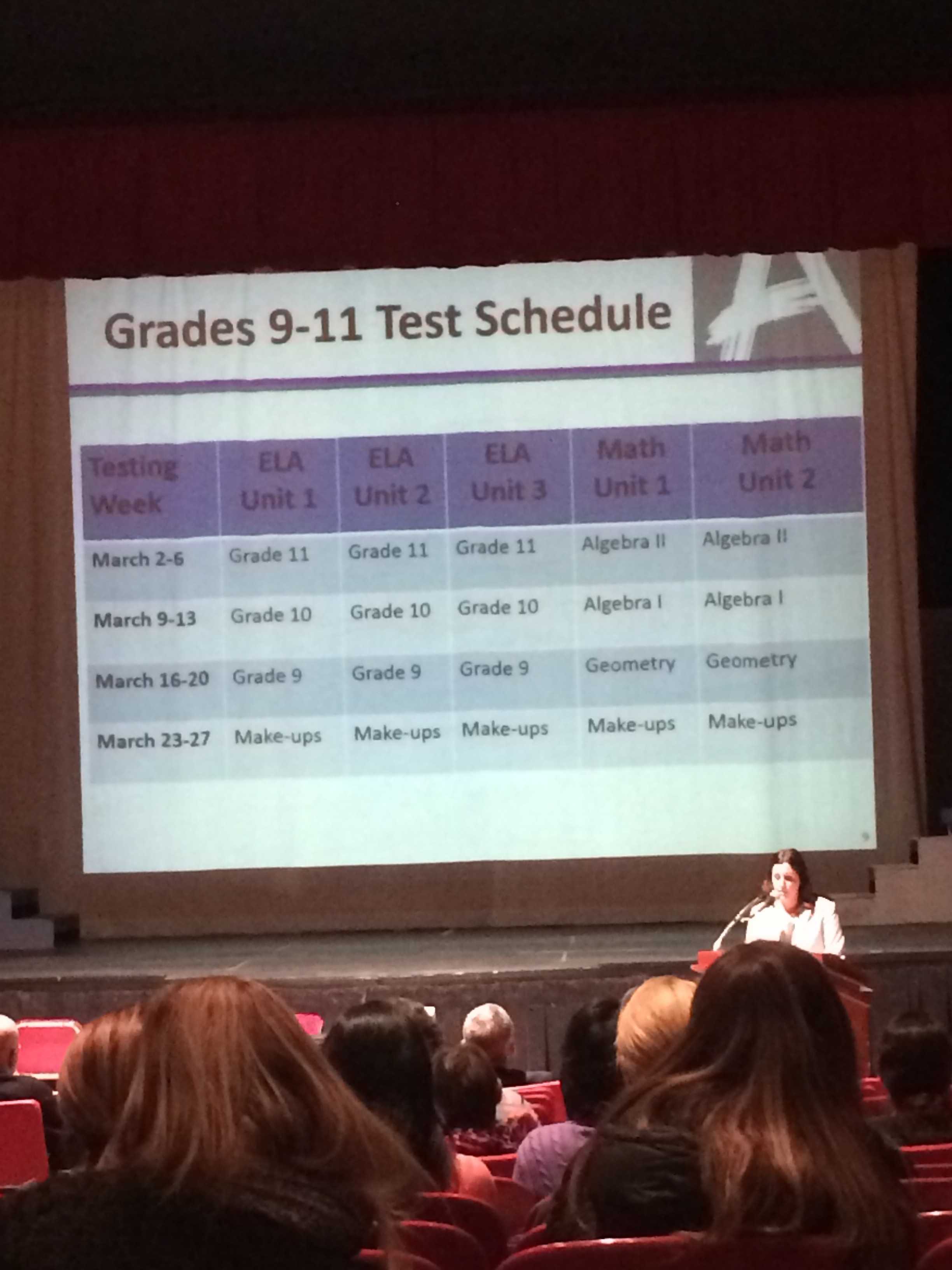New schedule for PARCC testing will begin on March 2
February 17, 2015
Beginning on March 2, and continuing throughout the month of March, Cherry Hill East will switch to a yet another new schedule as freshmen, sophomores, juniors and any students currently enrolled in Algebra I, Algebra II or Geometry will start to take the PARCC test.
While many teachers, parents and students have expressed concern over this new and complex schedule, administration found it as the least disruptive possible schedule to the curriculum, given the school district’s limited resources. A district-wide committee consisting of teachers, administrators, a child study team and counselors from both of the high schools started discussing PARCC.

A preview of the PARCC schedule for East students shown at a public meeting at Cherry Hill East.
“We started last year to talk about what we can do. We [knew] that there are two windows of testing which are 20 days long and 15 actual days of testing and five days of makeup, [so we discussed] what would be the least intrusive to the school environment and which would have the least impact on the overall classroom time and the overall instructional opportunities for kids,” said Assistant Superintendent Joseph Meloche in an interview with students from Eastside.
For districts as large as Cherry Hill, scheduling for PARCC proved to be very difficult because Cherry Hill has so many schools and students without having enough resources and space to be able to present the test to many students at once. The district spent a little over 650,000 dollars this academic year with the purchase of hardware, desktops, laptops and chrome books. However, these purchases are still not enough to accommodate for all of the students in the district. Thus, testing in the district has to occur over a long period of time.
The official schedule put together consists of an on and off rotation between days five and six for the first three weeks of March with the last week consisting of make-ups. On the first day five, period A will meet first followed by period B. In the afternoon, students will go to their period E class followed by their period F class. However, on the second day five, period B will occur first thing in the morning followed by period A afterwards. In the afternoon, period F will then come before period E. Similarly, the first day six will consist of the regular CDGH order while the second day six will be DCHG.
“The utilization of the days five and six is because there’s only four classes that meet rather than the six and they can build the testing in so [the tests are] not first thing in the morning and not the last thing in the afternoon. Because they could adjust the schedule, [it] seemed to have the least amount of impact on the overall schedule,” said Meloche.
Testing will occur during the periods right before, and right after the hour-long break period. These periods could last for 90 minutes or two hours depending on how long the testing is session. While these periods may seem excessively long, especially to have every day for most of March, Meloche said that although the time is a concern, the expectation is that teachers will use this time wisely and not just lecture for the entire class period.

We started last year to talk about what we can do. We [knew] that there are two windows of testing which are 20 days long and 15 actual days of testing and five days of makeup, [so we discussed] what would be the least intrusive to the school environment and which would have the least impact on the overall classroom time and the overall instructional opportunities for kids.
— Dr. Joseph Meloche
The first three days of each week will consist of ELA (English Language Arts/Literacy) testing and the last two days will consist of the math testing. Juniors and Algebra II students will test from March 2-6, sophomores and Algebra I students will test from March 9-13 and freshmen and Geometry students will test from March 16-20.
The classes that consist of mixed level students will continue to meet regardless of students missing the class in order to take the PARCC test. This fact has caused some students and parents to worry about the amount of work the students will have to miss.
“Our expectation is that the teachers will be working with the kids [who are missing classes] and will not be presenting, especially in a mixed class like that, a tremendous load of new information and that [they will] work with the kids so that they can get the information that they need,” said Dr. Meloche in reference to concerns about mixed classes.
If the school district had the resources, the testing could be completed more efficiently more timely and with fewer concerns; however the district has to work with its limited resources and present it to the students no matter the concerns because it is a statutory requirement.
“If we were a one-to-one district…we probably would not test everybody at the same time but we certainly would test grade levels at the same time. And could we get it done in a week? We probably could…we are limited based on technology and space with where we are,” said Meloche.
